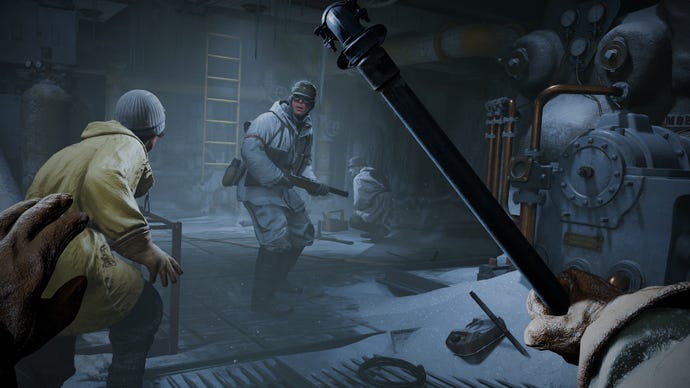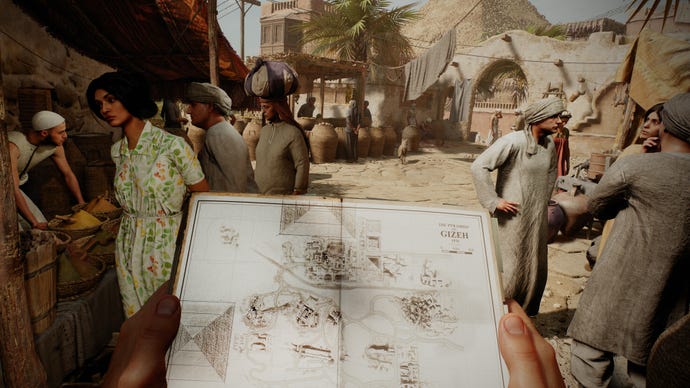Tech
Indiana Jones And the Great Circle redefines the gun-toting archaeologist as a grabby Lucasfilm fanboi
.jpg?width=1200&height=630&fit=crop&enable=upscale&auto=webp)
Going by three hours with a preview build last month, the Indiana Jones of Indiana Jones And The Great Circle has the hungriest hands this side of Thief 2014. They’re always surging into view, reaching restlessly toward objects as you explore, for there is ever so much to touch: photos and letters; pipes, frying pans, and other blunt implements; relics that translate into “Adventure Points”, used to “unlock” books of skills; camouflaged levers and other chunks of fusty comicbook exotica that harbour clockwork secrets. Sometimes, Indy’s magic fingers help you glean an object you need from the game’s religiously-sourced piles of Lucasfilm memorabilia. Sometimes, they exhaust you: please, Dr Jones, for the love of George. Stop trying to pick things up. Let me look at “ancient history” for a while.
The game’s almost sensual need to lay Indy’s mitts on everything says a lot about Indiana Jones as a character who figures things out as he bumps into them. It also speaks to The Great Circle’s unsurprising and rather numbing portrayal of “history” as a collectible commodity, but let’s not get too self-righteous straight off the bat. Let’s start with Indy himself.
The original Harrison Ford character from the 1980s is one of the great comedic improvisers – not quite up there with Jackie Chan or Charlie Chaplin, but streets ahead of James Bond and his pocketful of Chekov’s gadgets. Indiana Jones action scenes are all loosely coordinated blundering about and miraculous accidents – slumping bodies turning parked planes into rotating death traps, childish fake-outs and fistfuls of thrown sand, John Rhys-Davies punching a guy through a newspaper. Making do with what’s immediately at hand is the name of the game, and this is broadly how MachineGames want you to approach the Nazis in The Great Circle.
Above all, this comes across in the scarcity of permanent equipment, which might shock a player arriving fresh from the developer’s previous Wolfenstein shooters. Indiana Jones isn’t really an equipment guy, as you’ll learn when you pack his suitcase for him during the prologue, shortly after a bruising encounter with an oversized museum robber. He has a couple of stand-bys: his whip, used to snare ankles and swing from highlighted surfaces, and his pistol, for which he seldom has enough bullets. Beyond that, he’ll make do with whatever’s available: a broken bottle, an ornamental goblet, a metal fly swatter, a broom, anything with a handle and enough heft to break a bone.

All these items are thoroughly disposable, typically shattering after one or two swings, and freeing your hands to grab something else in the next room along. Often, of course, you’ll rely on Indy’s fists: he can parry, counter, jab and haymaker. But in the absence of self-replenishing health, he’s just brittle enough that, more often than not, you’ll want to open a punch-up by rudely hurling a roll of bandage, or deleting one of the brawnier sluggers with a sledgehammer.
These freestyle exchanges are the heart of a game that, as with the developer’s Wolfenstein shooters, sometimes feels like it wants to be an immersive sim. There’s an alleyway in Rome where you have a choice of higher or lower routes past patrolling blackshirts. You can creep up and knock people out, hide bodies, eavesdrop on chatter about Mussolini, and find keys for side areas harbouring collectibles. Later, a relatively sprawling Gizeh map lets you roam between excavation sites, tent cities and Nazi encampments, speaking to various NPCs and completing main and optional quests in any order. It’s the basis for a collection of miniature scenarios that might see you briefly donning a disguise, or searching for a hidden crawlspace after buying a key item from the market down the road. But these flourishes never quite go full Dishonored, and the game’s love of improvising with randomly grabbed tools is more compelling when it’s the basis for slapstick comedy.
I spent five minutes in one particular Egyptian tomb having a pipe-throwing contest with a single Nazi soldier on a gantry. It was all very Naked Gun. I kind of liked that shrieky little goosestepper. I don’t speak German, but it sounded like he was enjoying it too. I could have just shot him, I guess, but The Great Circle’s shooting feels deliberately awful. Indy’s pistol has a sparky cowboy charm, but it’s mostly a difficulty modifier, drawn whenever you can’t be arsed to fight “properly”. You can also scoop up dropped firearms such as rifles and machineguns, but Indiana is no BJ Blaskowitz, and that gun will be tossed aside the instant you empty the magazine.
With allowances for this being a preview build with wobbly AI, the enemies don’t seem tuned for shoot-outs either. Guards who make for serviceable melee opponents lose all conviction under fire: they bumble around in your sluggish crosshairs, seldom taking cover. Again, I think this is more deliberate than not: the shooting is being framed as a point of last resort. Whenever I laid hands on an MP35 or whatever, I always felt like the Nazis were slightly embarrassed for me. But then I’d find another frying pan, and all would be well.
I don’t get the sense that the game’s unlockable skills will alter these rhythms much. So far, I’ve seen a lot of boring passive boosts, like weapons taking longer to break or more health, though there’s the odd goofy power-up, like being able to revive from KO if you can crawl over to your dropped fedora. This last skill involves a cutscene where Indy dusts himself off, that famous smirk slowly emerging from the corner of his scowl. It’s even funnier when the Nazi jarhead who flattened you is still spacing out in the background, but again, this could be a quirk of the preview build.
Indy’s kleptomania in The Great Circle feels true to the character, then. It’s less convincing when it comes to interactions with other characters, which give rise to some familiar ludonarrative disconnects. At one point in my hands-on, I met up with a friendly archaeologist who was trying to thwart Nazi looting of the local historical sites. “Soon, there will be no trace of history left in this place,” she mourned, as I absent-mindedly roved her tent stuffing pieces of Ancient Egyptian stoneware into my trousers. In the process, I got my hands on one of her own drawings, a tender pencil portrait of a woman. Surely this, at least, was an act of petty pillage too many? “Just a little sketch I made,” the character blithely declared, without even looking. “Take it if you like.” The drawing disappeared into my inventory along with all my other plunder, and obligingly converted itself into points.

In general, The Great Circle’s world feels like the usual triple-A compromise of impossible sheen at the price of a certain liveliness. Having left my friend the archaeologist, I walked into a bazaar on the Gizeh map and experimented with whipping the air. The whipcrack reverberated like a thunderclap through the crowded stalls, but the locals paid no attention. This is perhaps the nearest blockbuster games come to punishing the dick-swinging western protagonists they inflict on exoticised colonial settings. You don’t even get called a bloody tourist – you just get politely treated like a ghost.
At times, Indy’s constant need to pick stuff up feels like a caricature for The Great Circle’s own, insatiably fanboi approach to both the films it’s based on and the times and places they themselves portray. Everything from Harrison Ford’s smirk to the clownish paf of Jonesian fist on Third Reich jaw has been reverentially looted from the archives and wedded to a bunch of seeming 3D renders of real-life museum artefacts, whose precise roots I’d love to trace.
The presentation is handsome and glossy enough that it’s easy to forget that you’re engaging with a set of nested, smashed-together influences: a 2024 video game romanticising of a 1980s film romanticising of 1930s film romanticisings of various “lost” cultures, updated with recourse to latter-day imaging techniques and asset libraries. It is memorabilia tucked within memorabilia, a commodification of commodification. It’s enough to give you vertigo.
Sometimes, the game makes a show of asking you to think critically about the origins of all these things, rather than encouraging you to pick stuff up willy-nilly. The very first puzzle, in fact, is about identifying museum relics scattered across the floor and restoring them to their cases. It’s a fun early twist: having barely shown you the ropes of combat and movement, The Great Circle suddenly needs you to recognise cuneiform writing and distinguish between photographs of Syrian and Iraqi archaeological sites. As you explore later levels, you’ll also scrape together a journal’s worth of sketches, scribbled objectives and photographs taken using Indy’s nicely clattery camera, but this mostly just feels like a glorified codex screen, with some hints about optional secrets.
At the risk of sounding both pious and naive, the museum curator puzzle could have been an opportunity to get away from the grabby fannishness on show elsewhere. It could have been a chance to break down and think about the pulpy colonial history-making of Indiana Jones movies – the stories behind the props and puzzles these stories use to define and structure the “ancient cultures” they reduce to boxes of traps and treasure.
I don’t think this is wholly unrealistic, or just a demand to make statements at the cost of the Fun. It’s the kind of self-referentiality you find in MachineGames’ Wolfenstein projects, which manage to be silly, brainless shooters whilst also being chaotic feats of historical recombination. Imagine the satirical energy that went into that all-American Nazi high street from The New Colossus being applied to Indy temple tropes, such as golden heads on pressure plates or using the sun’s rays on a hidden door. I think that could be Fun. Still, this kind of gambit isn’t really the agenda of a blockbuster licensed game: the point is to polish up the relics and put them on display. You could at least let me smash one over a Nazi’s head, mind.








